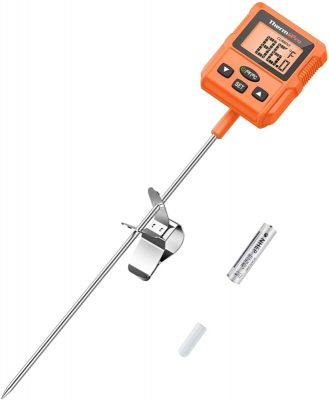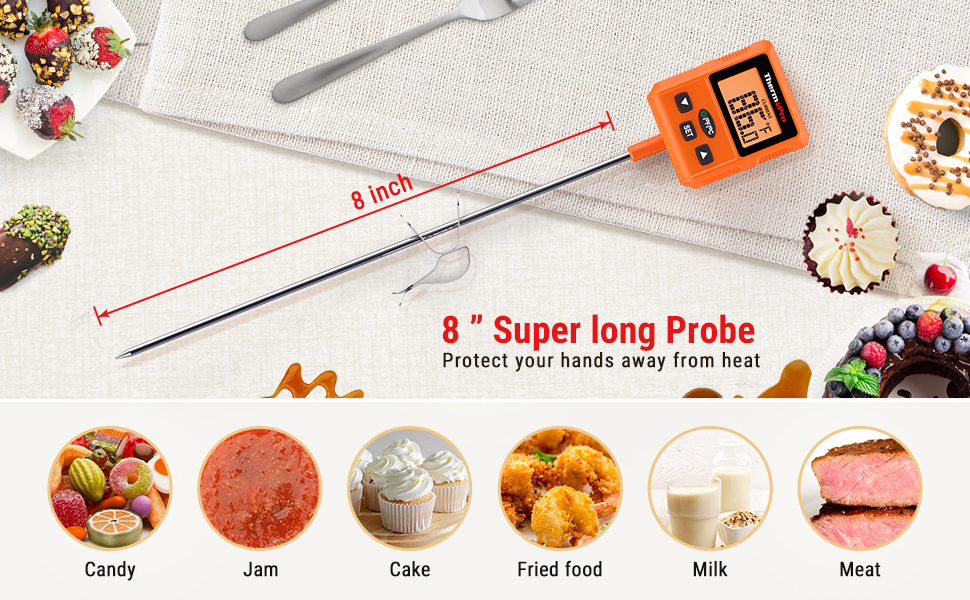The customer service team is always listening, taking notes, and quantifying complaints to ensure our products are continually improved. Due to selling directly to you, the customer, via Amazon, we can use product reviews to help us improve our existing products or help further development of new products.
Candy Temperature Chart: Make Candy Easier
Table of Contents
Candy making is a highly skilled craft that requires accurate temperature monitoring to do correctly. Whether you are making candy brittle, fudge, or caramels, the key to getting the texture and taste exactly right is only possible with the right temperature. To help us achieve this, we can use a candy temperature chart that tells you what happens to sugar at different heat levels, turning it into the sweet delights we all love.
Getting the right temperature with a candy thermometer guarantees high-quality texture and perfect results. Without one, you’ll likely to face a texture problem that makes candy taste grainy, or the sweets won’t set properly.
In the following blog, we will explore the whole topic, from learning how to make candy to making sure that your candy is tempered properly. We will further elaborate on why candy temperature is important and why it is necessary to measure it.
Here, you’ll learn why a candy thermometer is so important, and what types of candy thermometers are available. For example, the ThermoPro TP511 Candy Thermometer, a product featuring the newest technology, is one such device that features pinpoint accuracy and quick responses. We will explore its fundamental features and its necessary role in making candy. The other cool gadgets we looked at include tools for measuring candy temperature.
Love Food? Sign Up to Learn More
Get food blogs, tips, tricks, recipes & offers!
Thank you!
You have successfully joined our newsletter. Use this coupon code to get 10% off your next order: newsletter10
Why Does Candy Temperature Matter?
The temperature of candy during the cooking process is one of the most crucial factors in determining its quality. This is because it plays the most direct role in shaping the product’s texture and final result. If the temperature is maintained properly, boiling syrup can be converted into various types of candy such as ball, thread, or caramel candy.
With the help of a candy thermometer and a candy temperature guide, you can create many types of candy properly. These tools can keep you on track as you perform other important tasks such as setting the sugar concentration and measuring the amount of sugar to be used.
Standard candy treatment methods involve heating the mixture to the required temperature. A candy thermometer chart indicates the stage at which the candy mixture is to be treated. For this reason, measuring candy temperature properly is vital in the difference between success and failure.
Essential Tool for Measuring Candy Temperature
The ThermoPro TP511 Candy Thermometer is an essential tool for candy enthusiasts. By using it to cook sugar at different temperatures, this device can make different types of candy such as caramel or syrup.
The TP511 features an advanced 8-inch probe that ensures precise measurements with an accuracy of ±0.9°F. As well, it has a programmable preset and alarm function that prevents overcooking, ensuring your candy is cooked to the correct stage. The pot clip helps keep the thermometer steady so you will not get accidentally burnt by splattering hot oil. Versatile and practical, this candy thermometer can also be used to measure other ingredients during the cooking process such as meats and other proteins.

The Stages of Candy Making
Candy making requires a fine balance between proper timing and heat control. With a candy thermometer, you can be sure that your sugar syrup reaches the exact point needed to produce delicious candy.
Each stage of the candy-making process is associated with a specific consistency, ranging from soft and chewy to hard and brittle. By mastering these individual stages, you will be able to make several different types of treats such as fudge, caramels, and toffees.
What follows here is a detailed analysis of the candy cooking temperature chart:
- Thread Stage: 230–234°F (110–112°C): This is the phase in which the sugar in water drops part ways, and each strand hangs on its own in the cold water.
- Soft Ball Stage: 234–240°F (112–116°C): Cooling causes the sugar syrup to become soft, pliable balls.
- Firm Ball Stage: 244–248°F (118–120°C): When pressed, the syrup forms flat balls.
- Hard Ball Stage: 250–266°F (121–130°C): The syrup forms hard, solid balls.
- Soft Crack Stage: 270–290°F (132–143°C): When it cools, the syrup separates into thin threads and snaps.
- Hard Crack Stage: 300–310°F (149–154°C): This method produces hard, candy-like chunks.
- Caramel Stage: 320–350°F (160–177°C): The sugar turns brown and dark amber, and the taste becomes richer.
Tips for Successful Candy Making
- Alway be sure to use a candy temperature chart.
- Pay attention to the texture of the sugar syrup as the temperature increases; it can help you determine the current candy-making stage.
- In the same way, color changes (such as brown and dark amber) can help determine different stages of the candy making process.
- Ensure that the thermometer is correctly reading before heating the pot.
- Take your time. When sugar and water are heated very fast, they don’t form individual threads. Correctly heated sugar syrup is the best base for making candy.
Troubleshooting Common Candy-Making Issues
Here’s a detailed look at some common candy-making issues and how you can solve them:
Incorrect Temperature Reading: Ensure your candy thermometer is well-tuned before using it. Put it into boiling water, and if it is wavy and reads 100°C (212°F), your thermometer is functioning correctly. If not, perform a recalibration, or consider replacing it with a new one.
Crystallization Issues: Overheating and stirring the syrup afterward can trigger this problem. Use a clean spoon, and the melting should stop once the syrup has boiled.
Sticky or Hard Candy: Consider if you left the syrup boiling in the pot too long. The syrup level poured and the temperature at which it is brought may influence the final product.
Altitude Adjustments: Water’s boiling point normally falls as your location rises above sea level, so temperature adjustments may be required to achieve accurate results.
Conclusion
Close adherence to the candy temperature chart is essential for perfecting your candy creations. This guide helps you precisely navigate the stages of candy making, ensuring your sweets have the ideal texture and flavor. By following the candy temperature guide and the candy thermometer chart, you can confidently manage temperatures, whether working with table sugar or other types of sugar.
For flawless results every time, consider using the ThermoPro TP 511 Candy Thermometer. This tool accurately measures temperatures in Celsius and Fahrenheit, making it indispensable for achieving delicious results in every batch. Embrace the candy cooking temperature chart and enjoy making delightful treats!










